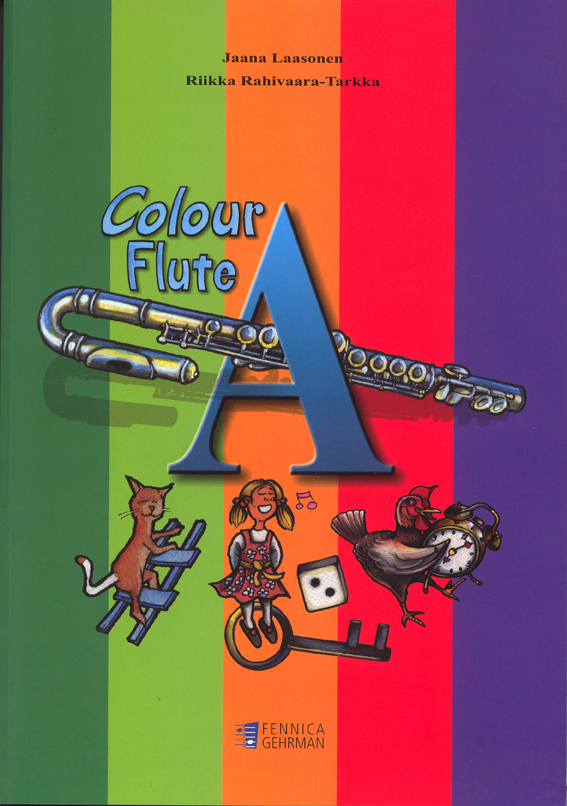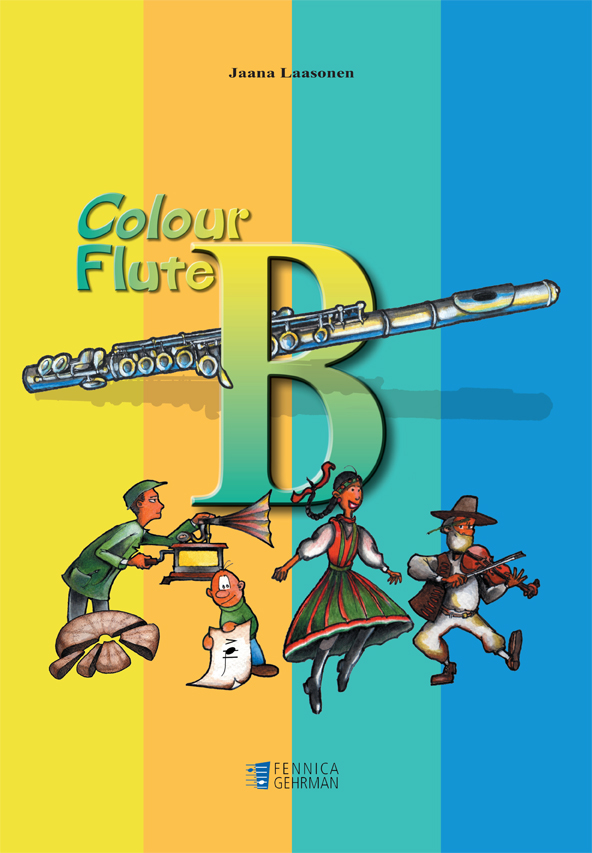This delightful method by Jaana Laasonen & Riikka Rahivaara-Tarkka uses colours, solmisation and an abundance of folk music material. It has been praised as one of the best in the world by flute teachers, and it supplies a solid foundation for improvisation, ensemble playing and overall musicianship. All in all the Colour Flute method – based on Szilvay’s popular Colourstrings – makes learning the flute fun! It takes as its starting point the character of the instrument and the world of the child, aiming at a flexible and versatile control of the instrument as well as improvisation skills, ensemble playing and overall musicianship.
Book A teaches C, G, D, F, B flat and their parallel natural minors. It does not include additional parts for the teacher. Instead, all the music is designed for the child to play. Two-part music is added with a view to developing the ear; accompanying notes at a third or a sixth are thus avoided at the beginning of the book because their intonation is still very difficult for children at this stage. The pieces do not have any modulations or chromatic notes. Buy the books in our web shop.
Opettajan opas (Teacher’s Guide for Book A) is available in Finnish.
Read about the method in Finnish (Ohjeita opettajille ja vanhemmille).
Special features of the method
Colours
Colours are an aid to learning, arouse interest and sustain motivation. They appeal to children and make learning enjoyable. In the Colour Flute method each key has its own colour, but so that the parallel major and minor are the same colour. This helps the child to visualize scales and the intervals within them and to assimilate the principle of relative solmisation in playing the flute.
Pictures
Rhythms, keys and other musical concepts are expressed and explained by means of pictures. This presents the grammar of music in a format the child can understand.
Rhythm
Rhythm is approached logically, gradually becoming more difficult. The visual symbols make the rhythms easy for the child to understand. Time signatures are expressed by a picture at the beginning of the stave showing how many TA or TI notes there are in the “bar house”. The teacher’s handbook suggests ways of accompanying the pieces with different rhythms.
Melody
The melodies likewise proceed in a logical order, from easy two-note songs to pentachords and hence to majors and natural minors.
Form
The pieces are short so that the forms are easy to grasp. Learning them by heart is warmly recommended. This improves the memory and makes for a freer interpretation.
Singing
Before the child begins to play a piece, it is a good idea to sing it using the solfa (DO-RE-MI) and rhythm names. Singing with words is an aid to natural phrasing and breathing and helps the child to sense the character of the piece. Attaching funny stories to the words maintains interest.
Technique
Each piece studies a new technical point. The technical progress is logical and controlled and aims far into the future. The Colour Flute method also teaches coordination over the long term using the exercises in the teacher’s handbook (to be published later).
Integrated tuition
In addition to teaching how to play, the Colour Flute method simultaneously promotes musical listening (solfa), cognitive skills (theory) and emotional development – all elements that should always be mutually balanced.
Use of the senses in teaching
The more senses the tuition uses, the more profound and lasting the learning is. For this reason we consider a method of reading and writing music that is rooted in the world of the child important in instrument teaching. It is the ability to read music that, in classical music, raises the finger dexterity learnt by imitating to a cognitive level and makes it art.
Reading music
Unlike in the Colourstrings method, the notation in Colour Flute Book A begins straight away with a five-line stave, because young flautists quickly progress to pieces requiring all the lines. The coloured notes appeal to the child and help him or her to grasp the sounds appearing in the piece. To make reading the music easier, the pieces have a DO/LA key showing the keynote. For the same reason the compass of the pieces is narrow at first.
Relative solmisation
The method uses relative solmisation, i.e., the movable DO principle. The solmisation names of the notes in the major scale are thus DO, RE, MI, FA, SO, LA, TI and DO. The same names are used for the minor key, but beginning on LA. The DO/LA key instead of a clef shows the keynote of the piece.
Relative solmisation has proved useful in teaching the flute: it makes figuring out tonal music, learning by heart and noting down much easier. Intonation improves to an astonishing degree. Transposing simple melodies, transforming and learning by ear are easy using solmisation. Improvisation also acquires new dimensions as the child’s ability to hear intervals and chords improves. The formation of different scales (modes, pentatonic and whole-tone scales) and chords is also later far simpler. The notes for the pieces on the grey or syllabi pages of the Colour Flute Book A are given with rhythmic values and below them the pitch with its solmisation name. These pieces are used to practise transposition and to master intervals. The teacher can always return to these syllabi pages when progressing to the next DO or LA and revise the solmisation names from their new positions.
The notes appear on the stave as if using the G clef to make the letter (absolute) names of the notes easier to learn later. The material in the book can thus also be taught using the conventional letter names. Using the solmisation names, the melodies can be sung at any pitch; using the letter names, the pieces should be sung at the given pitch. Thus the child may even acquire an absolute aural key memory.
Musical vernacular
It is of primary importance to the child’s musical, emotional and intellectual development for the instrumental tuition to be rooted in his or her own world. In addition to the children’s song treasures familiar from Géza Szilvay’s Rascal Songs series the Colour Flute method features a wide selection of folk music material for use in teaching the flute. At regular intervals the book has empty manuscript pages for the teacher to note down children’s and folk pieces from the child’s own environment. The teacher can thus adapt the method to the child’s own cultural background.
Creativity
Children can themselves use the exercise pages in the Colour Flute book. Little snatches of song they have written down (and invented) themselves activate them to write and read music and to be creative, to improvise and later maybe to compose.
Group teaching
Instrumental tuition relying solely on private lessons can easily become a lonely chore. Yet playing with others is an integral part of music. Making music in a group is inspirational and fun and encourages the child to keep playing. The children do not feel lonely if they can play with others of the same age. Colour Flute is designed to support group tuition.
Chamber music
Group tuition leads naturally to chamber music. The method is made all the richer by the wealth of ensemble repertoire.
Repetition
Playing pieces again and again is an essential part of instrument teaching. We recommend returning to the pieces many times, focusing on a different point (such as dynamics, tempo or timbre) each time and adding it to the piece.
Flute Chamber 1-4 (Huilukamari 1-4)
Lászlo Rossa‘s and Jaana Laasonen‘s series of chamber music repertoire for young flutists in four volumes is based on original versions for violin duos by Lászlo Rossa and Gèza Szilvay.
Book I is intended for groups of players of different standards. The top part is both technically and musically more difficult than the lower ones. The moods, tempos and stories are delightfully varied.
Book II includes duos, in which both parts are of the same technical standard and the accompanying part is a melodic or rhythmic obligato.
Book III is a selection of trios with lots of different characters and exercises in rhythm and intonation. The pieces are an entertaining way of exploring the world of music and capturing the moods of different stories.
Book IV is a book of quartets. The pieces are designed to develop the skills needed for playing in an orchestra (intonation in different octaves, rhythmic precision and quick changes of character).
Buy the books in our web shop


